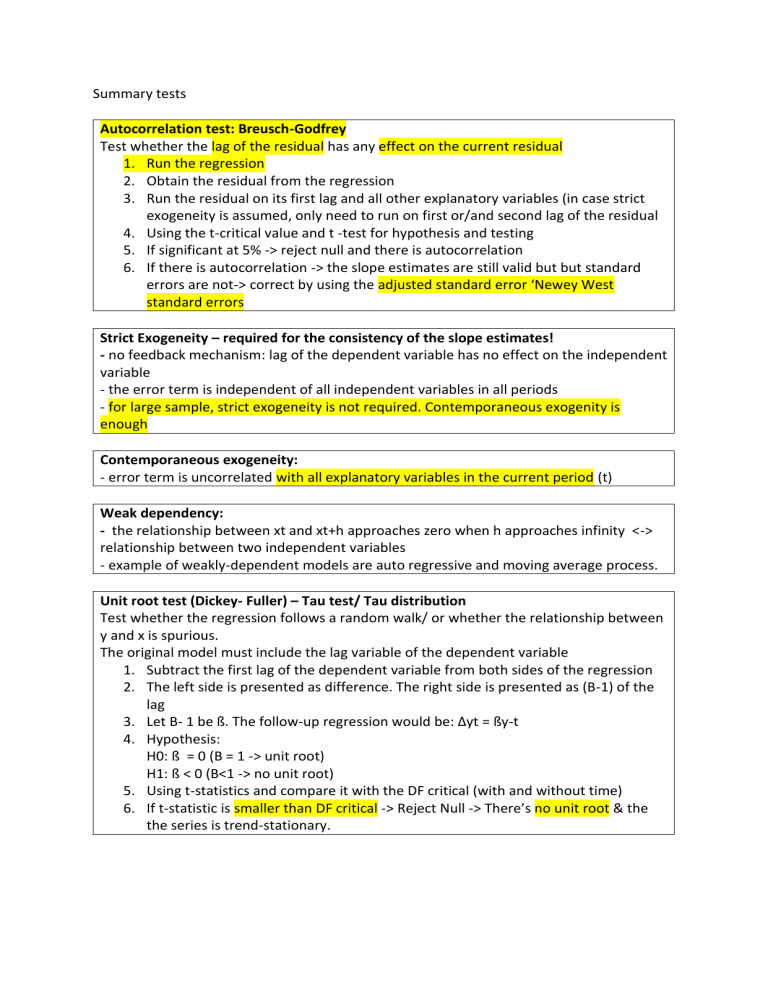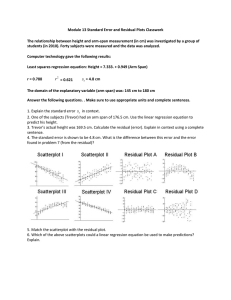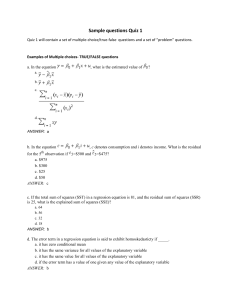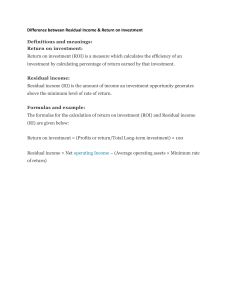
Summary tests Autocorrelation test: Breusch-Godfrey Test whether the lag of the residual has any effect on the current residual 1. Run the regression 2. Obtain the residual from the regression 3. Run the residual on its first lag and all other explanatory variables (in case strict exogeneity is assumed, only need to run on first or/and second lag of the residual 4. Using the t-critical value and t -test for hypothesis and testing 5. If significant at 5% -> reject null and there is autocorrelation 6. If there is autocorrelation -> the slope estimates are still valid but but standard errors are not-> correct by using the adjusted standard error ‘Newey West standard errors Strict Exogeneity – required for the consistency of the slope estimates! - no feedback mechanism: lag of the dependent variable has no effect on the independent variable - the error term is independent of all independent variables in all periods - for large sample, strict exogeneity is not required. Contemporaneous exogenity is enough Contemporaneous exogeneity: - error term is uncorrelated with all explanatory variables in the current period (t) Weak dependency: - the relationship between xt and xt+h approaches zero when h approaches infinity <-> relationship between two independent variables - example of weakly-dependent models are auto regressive and moving average process. Unit root test (Dickey- Fuller) – Tau test/ Tau distribution Test whether the regression follows a random walk/ or whether the relationship between y and x is spurious. The original model must include the lag variable of the dependent variable 1. Subtract the first lag of the dependent variable from both sides of the regression 2. The left side is presented as difference. The right side is presented as (B-1) of the lag 3. Let B- 1 be ß. The follow-up regression would be: ∆yt = ßy-t 4. Hypothesis: H0: ß = 0 (B = 1 -> unit root) H1: ß < 0 (B<1 -> no unit root) 5. Using t-statistics and compare it with the DF critical (with and without time) 6. If t-statistic is smaller than DF critical -> Reject Null -> There’s no unit root & the the series is trend-stationary. Heteroskedasticity: Breusch-Pagan test Test if the variance of the error term is constant or it varies across sample! 1. Run the regression 2. Obtain the residual 3. Square the residual 4. Run u^2 on all explanatory variables 5. H0: there is no relationship between u^2 and explanatory variables (all coefficients are equal 0) -> no heteroskedasticity 6. Use F-test to test for joint significance 7. If reject F-critical F(a, q, n-k-1) (a: significance level, q, number of restrictions, n: number of observation, k: number of variables) 8. If there is heteroskedasticity, the coefficient is still consistent, but we need to correct for heteros by adding the command robust! Or the cluster command in panel data! Choice between FE/FD vs RE specification: Hausman test 1. Run the re specification -> store it 2. Sun the fe specification -> store it 3. Test whether there is correlation between the specific unobserved effect (ai) and the explanatory variable H0: there is no relationship -> need random effect H1: there is relationship -> need fixed/ first difference effect 4. Compare the Chi statistic with Chi critical. If larger than Chi critical -> reject null and show preference for fixed/FD estimation. Endogeneity test: Hausman-Wu test Test whether the variable in question is indeed endogeneous 1. Run the first stage regression (regression of endogenous on explanatory variables) 2. Obtain the residual 3. Regress the y on all variables, including the endogenous and residual 4. Test for the significance of the residual using t-test H0: xt is exogeneous (B_xt = 0) H1: xt is endogeneous (B_xt # 0) 5. If endogeneous -> use IV regression 6. If exogeneous -> use OLS because IV or 2SLS would give larger standard error Validity of an instrument 1. Relevance: the instrument must share correlation with the endogenous variable -> test by running regression of endogenous variable on the instrument and other explanatory variable -> check for the coefficient and significance of the IV 2. Exogeneity: IV must be uncorrelated with the error term in the structural equation. Or IV must only have effect on y through x, NO DIRECT RELATIONSHIP Co-integration test To test whether two AR(1) variables are co-integrated or Test whether there is UNIT ROOT in the residual! 1. Regress the two AR(1) variables 2. Obtain the residual 3. Regress the difference of the residual on its first lag 4. Compare the t-statistics with the critical value (from co-integration table) H0: B_lag = 0: unit root (not co-integrated) H1: B_lag <0: no unit root - co-intgerated 5. Reject H0 if T-statistics is smaller than tau critical (with or without timetrend) Over-identification test: Sargan test To test whether the use of more than one IV for one endogenous variable is needed 1. Run the 2SLS regression 2. Obtain the residual 3. Run the residual on the IVs and all exogenous variables 4. Obtain R2 and number of observation H0: no over-identification H1: not H0 5. Using the Chi-critical – Chi(a, n-k) - n: number of intruments, k: number of endogenous variables; a: level of siginificance 6. Reject null if N*R2 > Chi-critical 7. If Reject -> the estimates obtained from two IVs for one endogenous is invalid -> need to drop one IV




